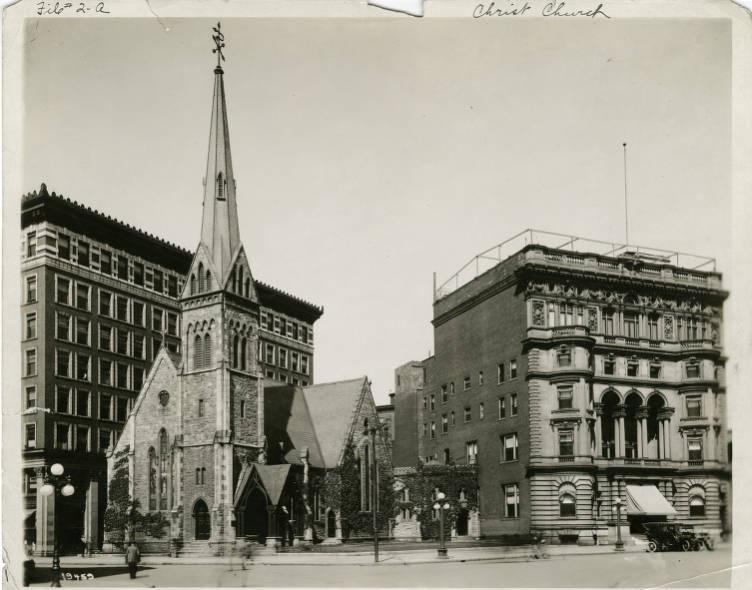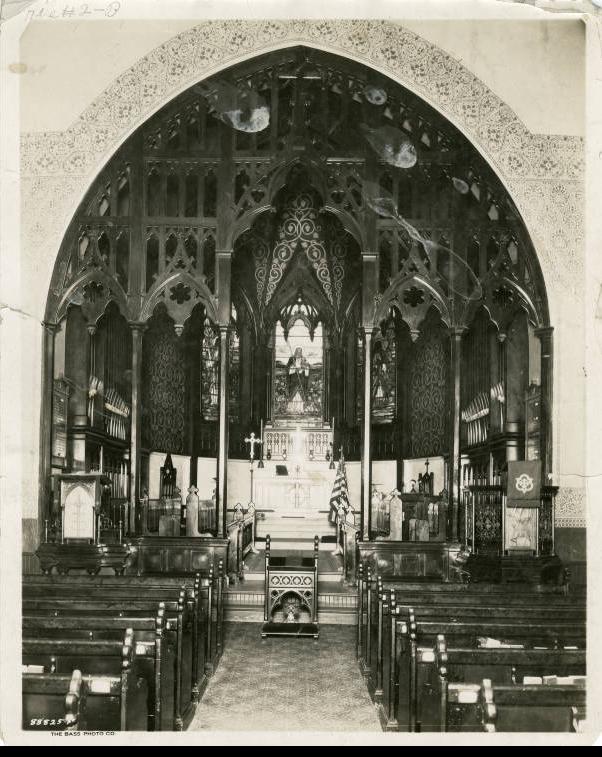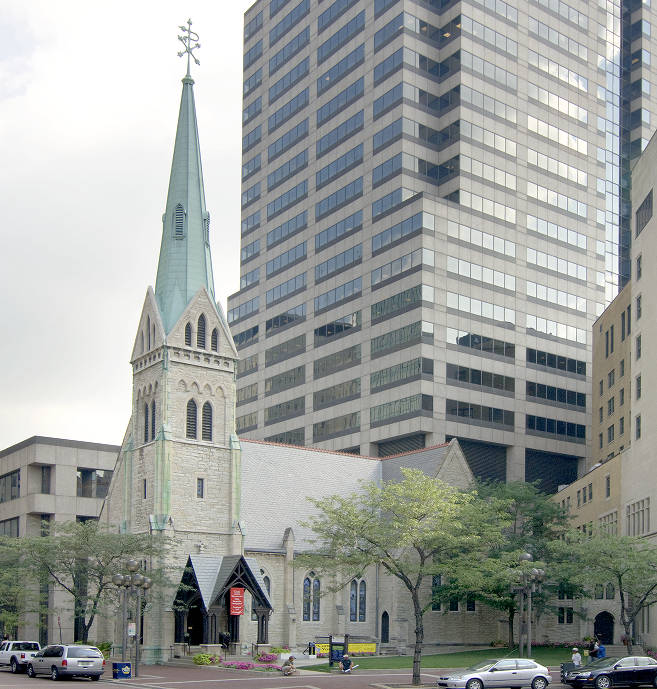In June 1837, resident Episcopalians purchased a lot on the Governor’s Circle () to build a church. Thirty individuals organized the Parish of Christ Church on July 13, with Rev James B. Britton, recently of Louisville, as rector. By Christmas, the congregation, which worshipped in a rented room on Washington Street, numbered 30 families and offered adult Bible and Sunday school classes.

Assisted by the fundraising efforts of Episcopal Bishop , the sale of pews, and donations (including one from Christ Church Louisville), parishioners financed the construction of a small frame gothic-style building, completed in November 1838. The church’s women subsequently held a fair in December 1839, to raise money for a church bell.
Christ Church quickly assumed a leadership role in the community. It hosted the second annual convention of the Diocese of Indiana, May 31-June 3, 1839, and five others over the next 13 years. In November 1839, Mrs. James (Susan B.) Britton announced the opening of a seminary for young ladies at Pennsylvania and Vermont streets. It was later succeeded by St. Mary’s Seminary, chartered by the Indiana General Assembly on January 15, 1844. By 1850, Christ Church numbered 153 adult parishioners and 108 children, with a Sunday school of 80 scholars and ten teachers.

In March 1856, the vestry appointed a committee to plan for a new church. It selected Irish-born architect , known for his work on North Western Christian University () and Center Hall at Wabash College. Parishioners began a subscription drive to fund their building project and sold their old building in 1857 to , which relocated to Georgia Street. After meeting in the during the construction period, on May 22, 1859, the Christ Church congregation held its first worship service in the new building, which cost $32,438 ($1 million in 2020). It is the same English Gothic structure seen on the Circle today.
Christ Church was affected by the Civil War. In June 1862, Rev. Horace Stringfellow Jr., a native Virginian and rector since 1860, resigned his post over unsubstantiated allegations regarding his southern sympathies, which stemmed from his work ministering to Southern prisoners of war at . He returned to Indianapolis from Canada in 1866-1867 to lead the new St. Paul’s Episcopal Church, which, composed primarily of Democrats, became known among opponents as “St. Butternut’s, the Church of the Holy Copperheads” or “Holy Rebellion.” In April 1865, the Christ Church choir sang at memorial services for slain President Abraham Lincoln.
Since its founding, Christ Church has conducted an active community ministry. It was the mother church for several missions and congregations, including St. Luke’s (1863), Grace (1864), St. Paul’s (1866), and St. George’s (1872-1873).
Beginning in the mid-1800s, Christ Church also developed a reputation for its quality music program. In 1883, the parish established a boys’ choir, the precursor of today’s renowned . The church has consistently upgraded its organ and provides occasional noon organ concerts.

After adding a new spire in 1869-1870, the church endured the hard economic times of the 1870s and witnessed the migration of other congregations into northern sections of the city during the 1880s. By 1884, Christ Church was the last of five churches that had once occupied the Circle. Between 1888 and 1900, there were repeated efforts to remove the church from the Circle and join with either St. Paul’s or Grace Episcopal churches or move to a new northside location. A move appeared imminent in 1898 when the neighboring was given an option to buy the church for $66,900. Following a public outcry and a grant from the Diocese of Indianapolis, the vestry voted against any move and appropriated funds for needed renovations.
Located at the city’s center, Christ Church became a focal point of wartime charity activities. During World War I, women’s auxiliaries met to sew garments for the Red Cross. Between 1942 and 1945, the church sponsored a servicemen’s “Social Hour,” later known as the Christ Church Canteen, which served thousands of servicemen and women who passed through wartime Indianapolis. With the outbreak of the Korean War, the church reactivated the canteen and again assisted military personnel.
One of Christ Church’s principal benefactors was . He provided the diocese with $1 million in 1953 for a large-scale renovation to the building and diocesan structure. Using this fund, Christ Church was instituted as the diocesan pro-cathedral (a church that serves as a cathedral without a permanent designation) on October 10, 1954. Lilly left an additional endowment at his death. He also served as diocesan historiographer and wrote a history of the institution entitled The Little Church on the Circle (1957).
The church also received widespread recognition for its urban ministry programs established during the rectorate of Cathedral Dean Paul Moore Jr. in the 1960s. Christ Church Cathedral was entered on the National Register of Historic Places in 1973.
Christ Church claimed over 630 members in 2020 and continued to serve as a pro-cathedral for the diocese, parish to members, and church to downtown Indianapolis. In January 2021, Rev. Gray Lesesne, the first openly gay clergy person at Christ Church, began his tenure as dean and rector of the church. He previously had served as Christ Church’s Canon and Senior Associate (2008-2015).

Help improve this entry
Contribute information, offer corrections, suggest images.
You can also recommend new entries related to this topic.

